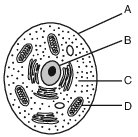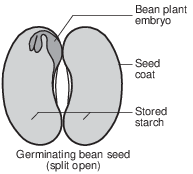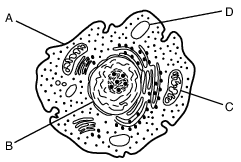Topic: Cell Structure And Functions
Cell Structure And Functions
Plant cells can synthesize energy-rich organic molecules, and later break them down to extract that energy for performing life processes. These activities require direct interaction between the
(1) chloroplasts and vacuoles
(2) cell walls and ribosomes
(3) chloroplasts and mitochondria
(4) ribosomes and mitochondria
Which two cell structures work together in the process of protein synthesis?
(1) nucleus and chloroplast
(2) ribosome and vacuole
(3) nucleus and ribosome
(4) mitochondrion and cell membrane
Which observation could lead to the conclusion that an object is nonliving?
(1) It passes on hereditary information only through asexual reproduction.
(2) It carries out synthesis.
(3) It cannot perform metabolic processes.
(4) It is composed of a cell, but does not have tissues.
An ameba is a single-celled, heterotrophic organism. In order to meet its energy needs, it relies directly on the interaction of which cell structures?
(1) chloroplasts and the cell membrane
(2) the cell membrane and mitochondria
(3) nucleus and ribosomes
(4) vacuoles and the nucleus
Anabolic Steroids
Anabolic steroids are hormones that affect muscle growth. Many athletes take synthetic anabolic steroids, in hopes of developing larger muscles so they can perform better at their sport. These hormones can act like the hormone testosterone. When men take an excess of anabolic steroids, they can have an increase in feminine features. This is due to the fact that the excess of these chemicals signals the male body to stop producing testosterone.
This signal in the male body to stop producing testosterone is an example of
(1) an underproduction of estrogen
(2) a feedback mechanism
(3) an overproduction of testosterone
(4) a decrease in anabolic steroid use
Which statement best describes the organelles in a cell?
(1) All organelles are involved directly with communication between cells.
(2) Organelles must work together and their activities must be coordinated.
(3) Organelles function only when there is a dis- ruption in homeostasis.
(4) Each organelle must function independently of the others in order to maintain homeostasis.
Recently, researchers from Stanford University have changed mouse skin cells into mouse nerve cells. This was accomplished by inserting genes that control the synthesis of certain proteins into the skin cells. This type of research is often successful in advancing knowledge regarding the functioning of human cells because
(1) cells present in humans often function in similar ways to cells present in other organisms
(2) cells from different types of organisms function differently when transplanted into humans
(3) the cells in all complex organisms contain the same genes and function in similar ways
(4) cellular research using mice can always be applied to human cells since all complex organisms produce the same proteins

Structure X is a
(1) mitochondrion
(2) vacuole
(3) nucleus
(4) ribosome
Within which structure of an animal cell does DNA replication take place?
(1) vacuole
(2) cell membrane
(3) nucleus
(4) ribosome
The letters in the diagram below indicate some parts of a cell.

The function of which cell part is most similar to that of the human excretory system?
(1) A
(2) B
(3) C
(4) D

When water is available and growth begins, the plant embryo inside the seed secretes enzymes to digest the starch stored in the seed. The enzymes in cells of the plant embryo are produced directly by the
(1) ribosomes
(2) nuclei
(3) mitochondria
(4) vacuoles

Which structure is responsible for the passage of materials into and out of the cell?
(1) A
(2) B
(3) C
(4) D
Each body cell contains the same genetic information, but can differ in appearance and size. The diagram below shows three different types of cells found in the human body.

Explain why differences in these human body cells are a biological advantage. [1]
Allow 1 credit. Acceptable responses include, but are not limited to:
• — This allows these cells to be specialized for a specific function.
• — Differences in cells are related to different functions in the body.
Mitochondrial Replacement Therapy
Mutations in mitochondrial DNA (mtDNA) are associated with some severe human diseases and are inherited through the cytoplasm in the egg cell. These diseases vary, but often affect organs and tissues with the highest energy requirements, including the brain, heart, muscle, pancreas, and kidney.
Scientists have successfully used mitochondrial replacement therapy with monkeys. Scientists are considering using this technique to reduce the incidence of mitochondrial disease in children. The proposed treatment would involve removing the nucleus from an egg donated by a healthy woman and replacing it with an egg nucleus from a patient (mother) with mitochondrial disease. This would place the patient’s egg nucleus into the cytoplasm of the donor’s egg containing healthy mitochondria. The egg is then fertilized with the father’s sperm externally using in vitro fertilization (IVF) to produce a zygote. The zygote is cultured for a few days to produce an embryo.
Explain why the scientists used the cytoplasm from the donor’s egg. [1]
Allow 1 credit. Acceptable responses include, but are not limited to:
• — The donor’s cytoplasm contains mitochondria without the mutations.
• — The cytoplasm of the donor has healthy mitochondria.
• — The healthy mitochondria were there.
The Protein Shredder
In every cell, thousands of important processes are occurring around the clock. One of the ways a cell manages to coordinate all of these processes is by sending protein messages. After the protein messages are delivered and read, they need to be destroyed to prepare for the arrival of the next message.
The task of destroying these proteins falls on cell structures known as proteasomes. Think of a proteasome as a tubelike protein shredder. Protein molecules that have served their purpose are transported to the proteasome, unfolded, fed through the tube, and cut into smaller molecules that can then be used to synthesize new protein molecules. Proteasomes can shred any type of protein.
Individuals with a neurological disorder known as hereditary ataxia have been found to have an excess of protein in the cells of their brains and spinal cords. The abnormal level somehow leads to the death of cells in portions of the cerebellum. These areas of cell loss can be seen on a brain scan.
There are several forms of hereditary ataxia but all of them result in poor coordination. The symptoms progress over a period of years. In the beginning, the individuals experience only minor coordination problems. As time passes, the symptoms become worse. The affected individuals will have poor balance when walking. They will be clumsy and have difficulty talking and swallowing.
Explain why researchers could think that proteasomes might not be working correctly in nerve cells of individuals with hereditary ataxia. [1]
Allow 1 credit. Acceptable responses include, but are not limited to:
• — There is an excess of proteins in the cells of the brain and spinal cord.
• — There are abnormal levels of proteins in their nerve cells.
